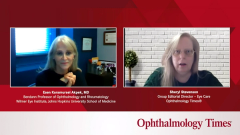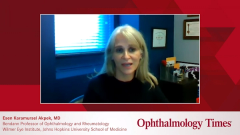
Open line between ophthalmology and oncology
The recent
The treatment is indicated for patients with relapsed/refractory multiple myeloma who have received 4 prior therapies, including an immunomodulatory drug, a proteasome inhibitor, and an anti-CD38 antibody. The approval was based on data from the DREAMM-2 study—in which the antibody-drug conjugate (ADC) elicited an overall response rate of 31% in patients who received the recommended dose of 2.5 mg/kg.
With the potential for corneal toxicities with this treatment, the collaborative role between ophthalmology and oncology in the management of these patients will be vital, according to Shaily Shah, MD, and Esen Karamursel Akpek, MD.
In the day-to-day practice, cornea specialists especially may be used to seeing patients with side effects or ocular manifestations of ocular cancers. These variable adverse events may present as disease- or treatment-related ocular toxicities, as Dr. Shah breaks it down.
“The first thing for me that comes to mind is something like graft versus host disease,” said Dr. Shah, Northern California Cornea Associates, Oakland and Walnut Creek, California. “That's something that we see quite commonly in patients, not necessarily as a side effect of the cancer itself, but for many of the hematologic malignancies, patients who undergo bone marrow transplants. As a consequence of that, oftentimes we'll have graft versus host disease.”
One of the common manifestations is ocular involvement, and usually corneal involvement. Patients will have severe ocular surface disease, and can have severe dry eye breakdown of the ocular surface, Dr. Shah noted.
(VIDEO) Dr. Shah: Ocular manifestations of multiple myeloma
“It's not manifestations of the disease that we tend to see; it's oftentimes side effects of the treatment,” according to Dr. Shah. “But that being said, there can be ocular manifestations of multiple myeloma. [Patients] can have orbital involvement or infiltration of the disease, and that can cause proptosis, or bulging of the eyes from their eye sockets.”
Ocular monoclonal gammopathy, also known as paraproteinemia, is a family of specific processes that result in ocular damage from the deposition of monoclonal immunoglobulins in various parts of the eye, explained Dr. Akpek, Bendann Professor of Ophthalmology and Rheumatology, Wilmer Eye Institute, Johns Hopkins University School of Medicine, Baltimore, Maryland. This deposition comes from high levels of circulating immunoglobulin in the blood, as seen most often in multiple myeloma, Waldenstrom macroglobulinemia, and monoclonal gammopathy of unknown significance (MGUS).
“It is a rare problem with less than 1% of patients with systemic gammopathies affected,” Dr. Akpek said. “While ocular symptoms due to gammopathy are rare, they can be the presenting symptom leading to the diagnosis of systemic disease.”
(VIDEO) Dr. Akpek: Observing ocular toxicity
Ocular diseases resulting from systemic gammopathy include paraproteinemic keratopathy, retinal vein occlusion, paraproteinemic maculopathy, crystal storing histiocytosis, and corneal copper aggregation, Dr. Akpek continued.
Paraproteinemic keratopathy (PPK) is among the best-studied ocular disease processes occurring with monoclonal gammopathy. It is also called corneal crystalline deposition, MGUS keratopathy, or MGUS associated corneal opacification. Deposits of monoclonal immunoglobulin accumulate and crystalize in the cornea resulting in the loss of visual acuity. The disease is most commonly associated with MGUS and multiple myeloma, although it has been reported with cryoglobulinemia, lymphoma, or autoimmune diseases. The exact clinical presentation and examination findings in patients with PPK vary widely.
Immunoglobulin deposition may occur intracellularly or extracellularly and has been seen in limbal vascular endothelium, corneal stroma, corneal keratocytes, and conjunctival fibroblasts. Immunohistochemical evaluations showed that these deposits could immunoglobulin light chain heavy chain, or both.
One common treated-related toxicity that ophthalmologists may see is in patients undergoing radiation, particularly near the head or neck. Patients can experience severe dry or scarring of their eyelids or lacrimal system, which, in turn, can cause ocular surface disease or difficulty closing the eyes, Dr. Shah said.
With this newest therapy for a treatment refractory multiple myeloma, belantamab mafodotin-blmf, ocular toxicity is something ophthalmologists may see fairly commonly.
“The keratopathy that we see in these patients is microcyst-like deposits in the epithelial layer of the cornea; that toxicity is actually quite common,” Dr. Shah said.
Approximately 25 to 30% of the patients experienced ocular symptoms during their belantamab treatment, Dr. Akpek noted. In most patients (about 70%) corneal findings were observed by slit lamp microscopy by dose 4. In vivo confocal microscopy revealed hyperreflective material. Mild symptoms like blurred vision (25%) and dry eye (15%) were the most common symptoms. Delaying or missing treatment is usually adequate in those, she noted.
What is interesting about this keratopathy, Dr. Shah added, is that the range of symptoms and adverse events is variable. Some patients that develop this microcystic keratopathy can be asymptomatic and seldom advance from very mild keratopathy, whereas for other patients, those cysts may progress and can start to move into the central cornea.
(VIDEO) Dr. Shah: Variable corneal adverse events
“They can start having decreased visual acuity, and they can start having subjectively blurred vision,” Dr. Shah said. “And if it's not treated, those cysts can continue to advance.”
Rarely, those cysts can start to erode through the epithelial surface, and patients can start having severe eye pain, burning, and punctate epithelial erosions that clinicians see on the exam. Very rarely, those erosions can coalesce and cause an epithelial defect or corneal abrasion, according to Dr. Shah.
“Corneal ulcers can even happen, but that is super, super rare,” she said. “Generally, if it's well managed, patients can do quite well.”
Management strategies
Dr. Shah noted that every patient at baseline who is going to be started on belantamab mafodotin-blmf should receive aggressive lubrication to the ocular surface.
(VIDEO) Dr. Shah: Management strategies for patients
Another strategy as part of the FDA-prescribing requirements is frequent eye examination so that ophthalmologists can monitor at every 3 weeks. The idea behind that is to be able to monitor the development of keratopathy and also the progression of keratopathy, Dr. Shah explained.
A specific grading system is used to determine the severity of the keratopathy, Dr. Shah added. If there is anything beyond grade 2, or basically moderate to keratopathy, generally she will advise holding the next dose of the patient's treatment.
“The good thing about the keratopathy that’s associated with [belantamab mafodotin-blmf] is that it actually is reversible,” Dr. Shah said. “So, when the treatment gets held, the keratopathy tends to eventually go away and resolve, and patients go back to their normal baseline.”
Once patients have returned to either grade 1 keratopathy or very mild keratopathy, or just back to their baseline, they can be restarted on belantamab mafodotin-blmf, at the same dose if their keratopathy was not that bad. If they had severe keratopathy, grade 3 or 4, sometimes patients will get restarted at a reduced dose of the medication, Dr. Shah explained.
In the majority of the cases with delaying the treatment or missing a treatment, these opacities went away. In some cases, the findings were severe. In rare cases, there were corneal ulcers, and the treatment had to be halted for a prolonged period, Dr. Akpek added.
“Obviously, if there are no corneal findings, these patients can take over-the-counter artificial tears to dilute the tear film, if you will,” Dr. Akpek said. “Dilution of the tear film is a good idea, but I doubt that that would alone by itself take care of the whole thing.”
As part of an effective management strategy, ophthalmologists need to be aware of potential complications. If a patient has multiple myeloma and they are on belantamab mafodotin-blmf, we become more vigilant about the corneal findings, Dr. Akpek noted.
“Tell the patients that if there are vision-related issues, blurring of the vision, or decrease of contrast, they should come have us take a look right away,” Dr. Akpek added.
Should ophthalmologists start to see the findings in the cornea, decreasing the dose or delaying the subsequent treatments should be considered. And in patients with corneal epithelial defects, or alterations with loss of stroma, the treatment should be halted—although those are rare, Dr. Akpek stressed.
An overall treatment strategy for these patients involves observing the progression of keratopathy, and quickly communicating with the oncologist about what is being seeing on the ophthalmic exam to determine whether the treatment needs to be held, and when it can be restarted.
“Delaying the treatment, the next treatment, or maybe decreasing the dose of it could be considered,” Dr. Akpek said. “I was thinking that we could use topical steroids, but unfortunately, that has been tried during the clinical trials and did not seem to have any effect on these opacities.”
“There's always a question that comes up about whether steroids would help for patients that have keratopathy from this drug,” Dr. Shah said. In studies so far, particularly DREAMM-2, Dr. Shah noted there was a substudy to look at ocular toxicity and the use of steroids to see if that would prevent ocular toxicity from occurring. “Topical corticosteroids did not make any difference in the occurrence of keratopathy,” Dr. Shah said. “It's really not recommended that we use steroids for these patients.”
For obvious reasons, treatment should be halted for patients who already have corneal ulcers, Dr. Akpek noted.
As additional strategies, Dr. Akpek noted that the remedies that ophthalmologists normally use for cornea also should be tried, such as tear duct plugs, amniotic membranes, bandage contact lenses, and lubricants.
“I don't know the role of serum tears in this case, because the serum probably also has the same the same toxic particles,” Dr. Akpek said. “But that's something that needs to be assessed, I suppose. Because it could be that these particles stained the serum just transiently if the serum tears are made, after the treatment, once the particles are where they're supposed to be after the administration of the treatment. Maybe serum tears could also be used because serum tears have gross factors that could be very useful in enhancing the epithelialization in the case there’s a corneal ulcer.”
Keeping lines of communication open
A multidisciplinary approach is crucial in the collaborative management of these patients. For Dr. Shah, this open line of communication begins with a paper form that is filled out when seeing these patients, either for an initial screening exam to determine their baseline ocular surface disease and baseline visual acuity, or for follow-up exams to see if patients have developed keratopathy or to determine the severity of their keratopathy.
Equally important is ensuring that open line of communication is maintained between ophthalmologist and oncologist. “I can directly send that form over to them, whether it's a fax and making sure that there's a reliable fax number, and somebody that's on the lookout for these faxes on the other end,” she explained.
Having been with an academic center previously, Dr. Shah said it may be easiest to send encrypted emails to the oncology office as soon as a patient has been seen. For ophthalmologists in a private practice or community setting, it may be more challenging to have a shared encrypted email system or shared electronic medical record system. “Sometimes, in those situations, you may be relying more on the patient to bring that form over,” Dr. Shah said.
Proximity makes a huge difference, Dr. Akpek stressed.
“I'm at a tertiary-care center,” Dr. Akpek said. “We're all in the same campus; it's very easy for the patient to be referred from oncology to ophthalmology.”
(VIDEO) Dr. Akpek: Open line between ophthalmology and oncology
Dr. Akpek explained that often a patient will walk from one building to another building, and they are seen right away. There are sometimes instances where oncologists might not have access to an eye-care provider, or they might not have access to an eye-care provider who is experienced in handling these cases that could pose a challenge.
(VIDEO) Dr. Akpek: Overcoming collaborative challenges
“It makes sense to identify capable and available eye-care providers ahead of time,” Dr. Akpek urged. “A network would be really useful in this case.”
Raising awareness
Another consideration for ophthalmologists is that patients starting treatment with belantamab mafodotin-blmf may have been refractory to multiple lines of prior treatment.
“This may be the thing that could be a life-changing medication for them,” Dr. Shah said.
Though ophthalmologists may be used to relatively quick exams and moving quickly in their clinics, sometimes these patients may need a little more chair time. Reassurance about their treatment regimen is important.
“Sometimes patients might dismiss their symptoms, particularly if they already had some dry eye symptoms from the prior treatments,” Dr. Akpek said. “Where there is connection or dialogue between ophthalmology and oncology is absolutely very useful in this case.”
Dr. Shah said it may be helpful to explain to patients: “Yes, ocular toxicity is quite common, there is a good chance you're going to develop it. If it develops you may have blurry vision, decrease in vision, but the good news is that this is reversible. We can hold the treatment dose until it resolves completely, and it is not a blinding toxicity.”
(VIDEO) Dr. Shah: How ophthalmologists can educate themselves
Moreover, self-education on the part of physicians will go a long way, Dr. Shah noted.
“It's something that both the oncology world and the ophthalmologist need to really be aware of,” Dr. Shah said. “As we see more and more patients getting treated with this medication, this toxicity is something that we're going to be starting to see much more frequently.
“The biggest thing is … to educate yourself on what does the keratopathy look like,” Dr. Shah said. “How do I grade it? And what sort of baseline treatments can I do to help manage the toxicities?”
References
FDA approves GSK’s BLENREP (belantamab mafodotin-blmf) for the treatment of patients with relapsed or refractory multiple myeloma.
News release . August 5, 2020. Accessed January 4, 2021.Lonial S, Lee HC, Badros A, et al. Belantamab mafodotin for relapsed or refractory multiple myeloma (DREAMM-2): a two-arm, randomised, open-label, phase 2 study [published online December 16, 2019]. Lancet Oncol. https://doi.org/10.1016/S1470-2045(19)30788-0.
Lonial S, Lee HC, Badros A, et al. Pivotal DREAMM-2 study: single-agent belantamab mafodotin (GSK2857916) in patients with relapsed/refractory multiple myeloma (RRMM) refractory to proteasome inhibitors (PIs), immunomodulatory agents, and refractory and/or intolerant to anti-CD38 monoclonal antibodies (mAbs). J Clin Oncol. 2020;38(suppl 15):8536. doi:10/1200/JCO.2020.38.15 suppl.8536
Newsletter
Don’t miss out—get Ophthalmology Times updates on the latest clinical advancements and expert interviews, straight to your inbox.















































